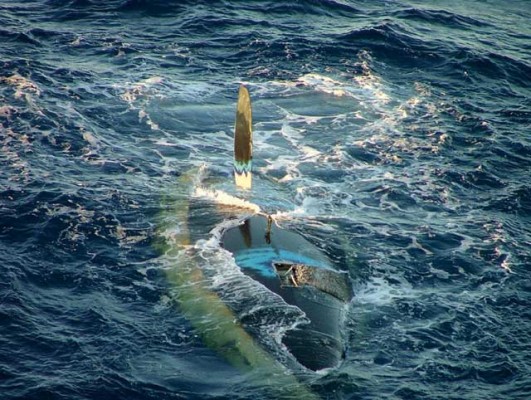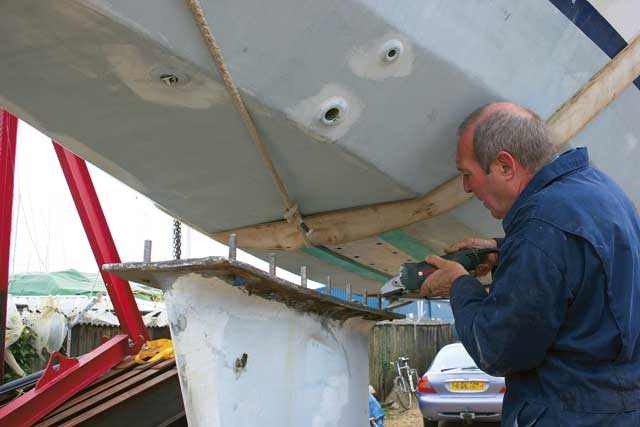Colin Brown describes a series of checks you can carry out to assess the structural integrity of the bolts which attach the keel to your boat
There have been some high-profile keel losses in recent times, and this has focused attention on keels and how they are held on. However, before you pale in fear, it’s important to remember that there are thousands of boats sailing around, and it is virtually unknown for a keel to just fall off. Many of the warning signs of keel attachment weakness are detectable with some simple checks that you can carry out yourself.
The tests described here are mainly aimed at fin-keeled boats with external ballast, as these are more prone to issues with their keels in comparison to long-keeled boats and those with encapsulated ballast. I’ve used the term ‘bolts’ to describe both keel bolts and studs throughout this article.
When a boat loses a keel at sea the first reaction is often to blame the keel bolts, but the evidence does not support this; and other failures are actually more common. In 2008, the International Sailing Federation (ISAF) set up a working party on keel losses, and they found 72 cases since 1984 of boats losing their keels. There were defined causes in 44.5% of cases, but only three were attributed to keel bolt failure. Other causes included welded fin failures (11), grounding collision (8), internal structure (8) and canting keel system (2).

When a boat loses a keel the first reaction is often to blame the keel bolts: but other failures are actually more common
This may be reassuring, but it does indicate that our checks need to be wider than just looking at keel bolts. I’ll outline the basic checks, but if you have any concerns get an expert to check your keel in person.
Internal ballast
If you have encapsulated internal ballast, then look for swelling or splits around the keel: in particular, check the leading edge and underside of the keel where it may have hit obstructions. Damage can let water in round the ballast, and iron ballast will swell as it rusts and can split the ballast top or cause bulges in the hull. Lead won’t rust or swell, but trapped water will swell if it freezes. If you suspect the keel has hit something (you may even have been at the helm at the time!), check internal structures for cracks and delamination.

This keel had clearly suffered some damage, and the layers are visible on the bottom of the keel. The ballast was lead and there was no swelling, although there was water weeping out from other parts of the keel. The damaged laminate should be ground back to let the water out
External ballast
It should be safe to assume that keel bolts have been specified by the designer to have an infinite fatigue life. This means that loads applied to them in normal use will never be high enough for fatigue to be an issue. Fatigue should only be an issue where corrosion has removed load-bearing area from the bolts. We can’t assume an infinite fatigue life for a hull, but normal use should not cause structural failure. Time will tell how long modern hulls last, and no boats seem immune to manufacturing defects. In all cases, seemingly small failures can allow the keel to move and this can spread to widespread separation of structures, loss of strength and ultimately to keel loss.
There are a number of signs that might indicate all is not well with your keel and its supporting structures. The checks listed below should take place after any grounding, and if you have never done them before. If in doubt, seek advice from a surveyor or an experienced repair yard. If you contact your insurance company they may appoint a surveyor of their choice.

Grounding damage. The puncture at the keel’s aft end is obvious. Less obvious are the external cracks reaching almost to the waterline and widespread separation of the internal reinforcing grid
External checks with the boat ashore
- Is there a gap between the keel and the hull? When the boat is lifted from the water, look at the hull-to-keel joint: it might seem a statement of the obvious, but check to see if there is a gap between the keel and the hull. Does the gap close when the boat is put down? A hairline crack in the antifouling is normal at a hull-to-keel joint, especially if flexible sealant has been used to seal the joint.

Gap at the aft end of a fin keel. The keel moved at least 5mm as it touched down. Sealant had clearly been added externally
- Are there rusty streaks from the hull-to-keel joint? It can be hard to judge the origins on an iron keel, but rust streaks on a lead keel with stainless steel bolts must be taken seriously.
- When the hull has dried out, is there water still leaking from the hull-to-keel joint? This is a clear sign that, at the very least, the seal has failed.
- Can you see cracks or damage on the hull? The keel may have moved and dislodged some paint. You may have to remove the coatings to expose the hull, but in some cases the cracks are visible through the coatings.

Cracks visible through the antifouling were traced out with chalk to make them show up

The same hull below the coatings
- Can you make the keel swing? Another obvious test is to push the bottom of the keel to see if you can move it. Does it swing when you let it go?
- With the boat resting on the keel, can you see any upward deflection of the hull? This can sometimes be seen aft of the keel where the hull should be flat and is less likely if there is a keel stub.
Failure in any of these tests suggests that the keel structure may have been weakened, and further investigation and probably repair is required.
Internal checks with the boat ashore
- Is there water in the bilge? Leaking keel bolts are a sure sign that all is not well, particularly with stainless steel. Check for other more obvious leaks, including the plumbing, to eliminate them before tackling the bolts.
- Look closely at the keel bolts, nuts and washers. Use a wire brush to remove built-up crusting and debris. Steel bolts often look terrible at first, but further investigation might reveal no significant loss of material.
- Nuts can be removed to allow inspection of the threads below. New nuts may be needed if there is any damage to the old ones, either from rust or removal.
- Rust stains round stainless bolts should be taken more seriously. If you believe your stainless steel keel bolts have been wet for some time, you must suspect that they are corroding and take action to investigate.
- Is there any sign that the bolts have moved? Check for telltale marks on the hull which may indicate this.
- Are the nuts loose? Quick application of a hammer or spanner may reveal a lot.
- Are the washers flat? Enlarged holes and re-tightened nuts may deflect washers into a cup shape.
- Glassed-over studs may have rust stains visible, and a light hammer may reveal one that sounds different from the rest.
- Do the sole boards fit, and do the doors still open and close? Both would indicate that the hull has changed shape. It could be that structures have been weakened or broken.
- Look closely round the structures that support the keel. You may have to remove screwed-down sole boards. Cracks are a sign of movement beyond design, and a light hammer can be used to find areas where the structures are no longer stuck to the hull.
- Are there obvious signs of repair? Is there any record of the repair? Poor finish and different colours are easy to see (as is dust) in hard-to-reach spaces. Signs that the keel was not removed, such as resin over the keel bolts or repair edges around the keel bolts, might be signs of inadequate ‘sticking plaster’ repairs.
- Painted studs and nuts may be a sign of good maintenance but could also be an attempt to hide something.

Cracked frames around the keel are a clear sign of excess movement

Poor repair work is easy to see, and in this case it was ineffective as the sole boards didn’t fit and the hull was deflected upwards aft of the keel
How to fix it…
If you suspect that your keel bolts are rusting, the only way to be sure is to lower the keel to have a look. This should not be taken lightly and will probably require a hoist or crane to support the boat. It may be possible to open a gap without dropping the keel completely. Have a strong structure ready to support the keel.

If lowering the keel, have a strong structure ready to support it
Even leaking and damaged keels may not lower easily, and some may have to be chiselled off.
If you find or suspect damage to the internal structure, then a full repair is likely to be complex and expensive and will probably require the keel to be removed to allow the hull to regain its proper shape. A few bits of matting and resin are seldom enough to replace lost strength.
As stated previously, if you’re in doubt you should seek advice from a surveyor or yard with experience of keel repairs. If you suspect you have a problem, contact your insurance company as you may be able to recover some of the cost.

This lead keel had to be chiselled off, hence the chisel marks

A broken bronze keel nut. You can see the brittle fracture zone along the outside. No crack was visible until the nut was removed

Dust in out-of-the-way corners is a sure sign that a grinder has been used
Further reading:
Keelbolt Surgery
After a few knocks a yacht’s keelbolts can work a little loose – but that might be just the beginning,…
Sealing a hull-to-keel joint
A reader's question about sealing a keel root answered by one of PBO's experts
Tips for re-sealing your hull/keel joint
Modify your scraper
Tidy up your keel/hull joint
Today's tip for a good join









